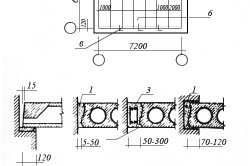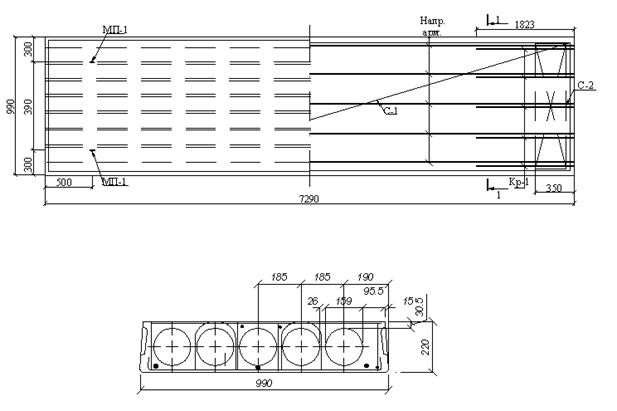Overview of floor slabs
Reinforced concrete floor slabs are currently an integral element in the construction of various buildings and structures. Simplicity of construction, as well as relatively low cost, made these plates the most popular material for the construction of any objects.
Hollow reinforced concrete floors of the PB series have many advantages over other materials. If we compare them with solid products, it becomes clear that a hollow structure with almost the same strength characteristics has a lower thermal conductivity, and this is an important aspect when using reinforced concrete products in the middle climatic zone. From the point of view of an engineering approach, hollow structures are much lighter than solid ones, this fact makes it possible to radically lighten the bearing capacity of walls. This is a very relevant moment in the construction of private households. Naturally, the price of hollow-core slabs is less than solid ones.
The photo shows a hollow reinforced concrete slab in section. It is clearly seen that six holes in the profile of the plate significantly lighten the structure, while maintaining its strength.
Choice between hollow core slabs and monolithic structures

Even at the project stage, the question arises of what type of floors should be in the future building. Generally, there are three main types. These are reinforced concrete hollow structures, monolithic and wooden floors. Of course, each type has both advantages and disadvantages. But hollow core slabs win in several respects. So, ceilings with holes in the section are an excellent heat insulator, they dampen sound waves quite well. The installation of such a product is in no way related to weather conditions, while work with it cannot be carried out at low temperatures. Hollow-core slabs of the PB type, after their manufacture, are already ready to take the design loads, while monolithic structures are supposed to withstand a certain period of time before the process of drying and hardening of concrete ends.
Plates of the PB series have a smooth surface, the horizontal level is maintained even during their production.
Wooden floors are used mainly in low-rise private construction due to their limited strength characteristics.
Back to index
Dimensions and classification of hollow core slabs

Reinforced concrete hollow slabs in most cases have in their marking the value of length and width. The ceiling height is most often 220 mm. A typical marking for these products is as follows PB-24-12 or PB-60-12. Where the values 24 and 60 are the approximate length of the products in dm, respectively, and 12 is the value of the width in dm. The hole diameter is 150 mm, sometimes there are products with a hole diameter of 159 mm. The phrase "approximate length" means that, for example, the product PB-25-12 has a length of 2480 mm, that is, this takes into account the gap when laying structures. PB products with a width of 12 dm, as a rule, have 6 holes in cross section. The given width of 12 dm is one of the most commonly used in construction due to its popularity, the calculation of structures very often leads to the use of slabs of exactly this width.
Back to index
Production of reinforced concrete hollow floors
Hollow type floor slabs PB are produced by formless molding. The calculation of the hollow structure suggests heavy high-strength concrete. Products are produced prestressed, reinforced with high-strength reinforcement. Reinforcement is carried out in the longitudinal direction. At a specialized stand, the future slab is molded onto stretched reinforcing ropes. The resulting product has a length of up to 200 m, after the concrete has hardened and dried, the product is cut to the specified lengths. Modern factories of reinforced concrete products produce slabs using the formless molding method with a length of 2.4 to 9.6 m. This possibility allows a large customer to place an order for a specific number of slabs. The calculation of reinforcement with steel ropes depends on the thickness of the future product.
It is allowed to manufacture ceilings with an oblique cut by special orders. There are old-style lines for the production of PC-type floors using metal moulds. This technology is considered obsolete and does not provide the advantages that PB-type products have. The slab cutting step is 10 cm, such previously unattainable values make it possible to calculate the building structure without reference to typical dimensions. Strengthening of such structures is achieved by prestressing concrete. Also, plates for some customers are made insulated using expanded polystyrene.
Back to index
The use of hollow core slabs in various areas of construction

Reinforced concrete hollow products with a width of 12 dm are often used in the construction of panel houses, garages of various institutions. Plates PB60-12 are used for ordinary residential buildings. Plates with a width of 12 dm are the most popular product. When designing most buildings, interfloor floors are formed exactly for this size. The new technology for the production of products of the PB series, of course, made it possible to master more complex projects, while avoiding the construction of monolithic ceilings. It is clear that in the most complex extraordinary projects one cannot do without monolithic technologies, but it has become much easier to design and build many buildings using slabs produced using the formless molding technology.
If we compare, for example, floors PK60-12 and PB60-12, it is clear that the use of the design of the PB series is preferable due to the fact that the slab produced using the new technology will have much more accurate geometric dimensions, an ideal plane. And this is an important quality in the further finishing of the building. Another important point is the increased strength of the slab, which makes it possible not to carry out additional calculations to strengthen the structures.
The calculation of reinforced concrete products includes several points. This is a calculation for deformation, a calculation for the opening of cracks. Structural reinforcement involves the technology of prestressing concrete. That is, the pre-tensioned steel ropes are released from loads after the concrete has been laid and set, and the force of the tensioned ropes is transferred to the hardened concrete. The product turns out to be stressed in compression, which makes it possible to withstand a significantly greater force during construction than a conventional design.
The design of any building includes the calculation of all possible loads even before construction begins. Sometimes there are situations when the constructed building is expanded by adding a floor or attaching additional buildings and constructing transitions. This event requires a careful calculation of the loads on the supporting structures, which almost always has to be done between the completed floor.
The scope of the work carried out must fully comply with the project, which provides for the calculation of reinforcing structures. Any work involving reinforcement of floors should be carried out only with a full calculation of the loads and forces acting on the slab. Any artisanal method, such as the usual placement of concrete in voids, is categorically unacceptable.
Currently, the volume of production of hollow core floor slabs of the PB series is increasing, as modern stringent requirements in the design of buildings require the highest quality and durable reinforced concrete products.
